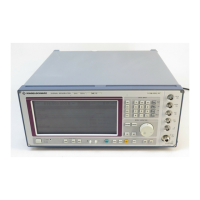SME Analog Modulations
1038.6002.02 2.57 E-13
EXT2 COUPLING
Selection of the type of coupling AC or DC for the external input EXT2.
IEC-bus command SOUR:FM1:EXT2:COUP AC
PREEMPHASIS
Selection of the preemphasis
IEC-bus command SOUR:FM1:PRE 50us
2.6.2.3.1 FM Deviation Limits
The maximal deviation depends on the RF frequency set (cf. Fig. 2-26). It is possible to enter a
deviation that is too high for a certain RF frequency or to vary the RF frequency to a range in which the
deviation can no longer be set. In this case the maximally possible deviation is set and an error
message is displayed.
In the RF range 93.75 MHz to 130 MHz a different synthesis range is selected depending on the
deviation set. If the deviation is smaller than 62,5 kHz, the synthesizer is in the division range with
optimal spectral purity. If the deviation set is larger than 62,5 kHz, the extended heterodyne band is
automatically selected.
2000
1000
500
250
125
62,5
0,005 93,75 130 187,5 375 750 1500 3000
extended
heterodyne band
maximal
FM-deviation
[kHz]
RF-frequency [MHz]
4000
6000
Fig. 2-26 Dependency of the FM maximal deviation on the RF frequency set
2.6.2.3.2 Preemphasis
Preemphasis results in a preemphasis of the modulation signal with time constants 50 µs or 75 µs. The
higher frequencies of the modulation signal are preemphasized.
When preemphasis is switched on, only 1/4 of the maximal deviation is permissible. The highest
permissible modulation frequency is 15 kHz. Exceeding the permissible modulation frequency can lead
to overmodulation.

